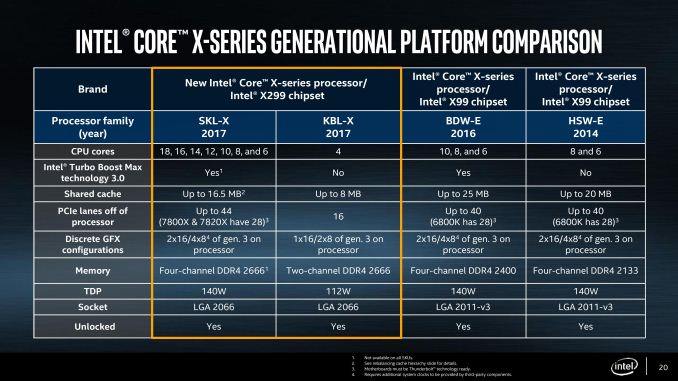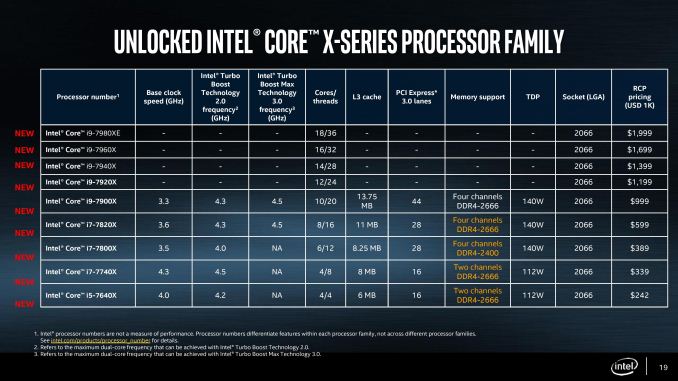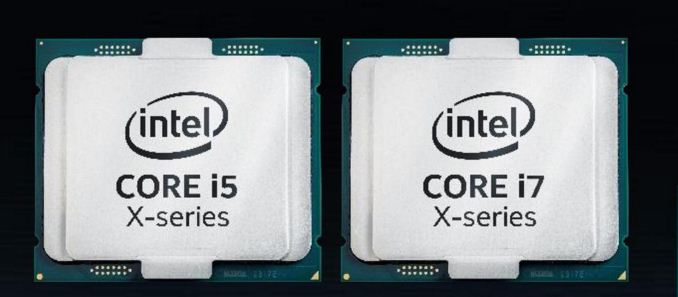The Intel Skylake-X Review: Core i9 7900X, i7 7820X and i7 7800X Tested
by Ian Cutress on June 19, 2017 9:01 AM ESTThe Basin Falls Platform: X299, SKL-X, & KBL-X
For most practical definitions of the Basin Falls platform, the X299 chipset is the heart. X299 supports the new processors, and like the Z170 and Z270 counterparts on the mainstream consumer line, is basically a big PCIe switch. One of the issues with the older X99 chipset was its limited capabilities, and inability to drive many PCIe devices – this changes with the big switch mentality on X299. For the DMI 3.0 link going into the chipset (basically a PCIe 3.0 x4), the chipset has access to up to 24 PCIe 3.0 lanes for network controllers, RAID controllers, USB 3.1 controllers, Thunderbolt controllers, SATA controllers, 10GbE controllers, audio cards, more PCIe slot support, special controllers, accelerators, and anything else that requires PCIe lanes in either an x4, x2 or x1 link. The total uplink is limited by the DMI 3.0 link, but there will be very few situations where this is saturated. There are a few limits to what support is available (some ports are restricted in what they can handle), and only three PCIe 3.0 x4 drives can use the in-built PCIe RAID, but this should satiate all but the most hardcore enthusiasts.
The Skylake-X family of processors for Basin Falls comes in two stages, based on the way the processors are developed. Normally HEDT processors are cut down versions of enterprise processors, usually through restricting certain functions, but the enterprise processors are typically derived from three different silicon layouts during manufacturing. Internally Intel call these three layouts the LCC (low core-count), HCC (high core-count) and XCC (extreme core-count), based on the maximum number of cores they support. Nominally Intel does not disclose which silicon layout they use for which processors, though it is usually straight forward to work them out as long as Intel has disclosed what the configurations of the LCC/HCC/XCC dies are. In this case, Intel has officially left everyone guessing, but the point here is that historically Intel only uses the LCC silicon from the enterprise line for its consumer desktop processors.
In previous generations, this meant either a 6, 8 or 10 core processor at the top of the stack for consumers, with lower core count models being provided by binning/salvaging imperfect CPUs. Each year we expected one of two things: the top-end SKU either gets more frequency, less power, or more cores, and as such the march of progress has been predictable. If you had asked us two months ago, we would have fully expected Skylake-X to top out with LCC silicon at 10 or 12 cores, depending on how Intel was planning the manufacturing part.
So the first element of Intel’s launch is the LCC processors, running up to 10 cores. We previously published that the LCC silicon was 12 cores, but we can now show it is 10 – more on that later. The three Skylake-X CPUs launching today are using LCC silicon with 6, 8 or 10 cores as the Core i7-7800X, Core i7-7820X and Core i9-7900X respectively. Intel is further separating these parts by adjusting the level of official supported DRAM frequency, as well as the PCIe lanes. We’ll go in a bit more detail further in the review.
The second element to the Skylake-X launch is the one that has somewhat surprised most of the industry: the launch will contain four processors based on the HCC silicon. Technically these processors will not be out until Q4 this year (one SKU coming out in August), and the fact that Intel did not have frequency numbers to share when announcing these parts shows that they are not finalized, calling into question when they were added to the roadmap (and if they were a direct response to AMD announcing a 16-core part for this summer). We’ve written a detailed analysis on this in our launch coverage, and we’ll cover some of the topics in this review. But Intel is set to launch 12, 14, 16 and 18-core consumer level processors later this year, with the top part running a tray price (when you buy 1k CPUs at a time) of $1999, so we expect the retail to be nearer $2099.
It should be noted that due to a number of factors, the Skylake-X cores and the communication pathways therein are built slightly differently to the consumer version of Skylake-S, which is something discussed and analyzed in this review.
The final element to the Basin Falls launch is Kaby Lake-X. This is also an aspect of the Basin Falls platform that deviates from the previous generations. Intel’s HEDT line has historically been one generation behind the mainstream consumer platform due to enterprise life cycles as well as the added difficulty of producing these larger chips. As a result, the enterprise and HEDT parts have never had the peak processing efficiency (IPC, instructions per clock) of the latest designs and have sat in the wings, waiting. By bringing the Kaby Lake microarchitecture to HEDT, this changes the scene, albeit slightly. Rather than bringing a new big core featuring the latest microarchitecture, Intel is repurposing the Kaby Lake-S mainstream consumer silicon, binning it to slightly more stringent requirements for frequency and power, disabling the integrated graphics, and then putting it in a package for the high-end desktop platform. There are still some significant limitations, such as having only 16 PCIe 3.0 lanes and dual channel memory, which might exclude it from the traditional designation of being a true HEDT processor, however Intel has stated that these parts fill a request from customers to have the latest microarchitecture on the HEDT platform. They also overclock quite well, which is worth noting.
The Kaby Lake-X parts will consist of a Core i7 and Core i5, both of which are quad core parts, with the i7 supporting hyperthreading. We have a parallel Kaby Lake-X review alongside our Skylake-X coverage, with some numbers from a stable 5 GHz overclock.













264 Comments
View All Comments
Soheil - Sunday, June 25, 2017 - link
Anyone knows why 1600X better than 1800X?OddFriendship8989 - Thursday, June 29, 2017 - link
I'm late here as usual but why are you not comparing against the 7700k and 7600k? I get that these are HEDT chips, but it's worth comparing against the high end mainstream especially when the 7800x and 7700k are priced similarly that someone MIGHT consider jumping over.I hate to say it but this is the typical stuff you guys used to do, and I know it takes more time to put together more CPUs, but logical comparisons MUST be made and these charts show a bit of laziness.
ashlol - Friday, June 30, 2017 - link
can we have the GPU tests pleaseOxford Guy - Saturday, July 1, 2017 - link
"The discussion on whether Intel should be offering a standard goopy TIM or the indium-tin solder that they used to (and AMD uses) is one I’ve run on AnandTech before, but there’s a really good guide from Roman Hartung, who overclocks by the name der8auer. I’m trying to get him to agree to post it on AnandTech with SKL-X updates so we can discuss it here, but it really is some nice research. You can find the guide over at http://overclocking.guide."If you have a point to make then make it. After all, you said you've already "run" this discussion before. Tell us why polymer TIM is a better choice than solder (preferably without citing cracks from liquid nitrogen cooling).
ashlol - Monday, July 3, 2017 - link
Anyway both are bad since you have to delid it to achieve good cooling. I have delidded a 4770k and a 6700k and put liquid metal TIM between the die and the IHS and they both run 15°C cooler at 4.6-4.7GHz@60°C with custom loop. And from seeing the temperature under overclock I will have to delid those skylake-x too.parlinone - Tuesday, July 4, 2017 - link
What I find most shocking is a $329 Ryzen 1700 outperforms a $389 7800X at Cinebench...for less than half the power.The performance to power ratio translates to 239% in AMD's advantage. That's unprecedented, and I never imagined to see that day.
dwade123 - Thursday, July 6, 2017 - link
Only in Cinebench and AES is where Ryzen look good. 7800x beats the 1800x in everything else in this review. Ryzen is too inconsistent in both productivity and gaming. It is priced accordingly to that and not out of good faith from AMD. This is also the reason why Coffee Lake will only top out at 6 cores. because it can consistently beat the best Ryzen model.IGTrading - Friday, July 14, 2017 - link
I absolutely disagree with the conclusion. The correct conclusion can only drawn when comparin apples to apples. Oh, if you want to be objective and compare apples to oranges, you can't just take into considerantion today's benchmark results and price. Have we forgotten about the days we REVIEWERS were complaining about the high power consumption of Pentium 4 and Pentium D ?! What about the FX 8350 ?! Is power consumption not an objective metric anymore?! What about platform price ?! What about price/performance?! Why do some people get suddenly blinded by marketing money?! Conclusion: i-7900X is the highest performance the home power user can get today if money for the CPU , mobo and subsequent power consumption are not an issue. Comparing apples to apples or core for core, the i7820X clearly shows Intel's anxiety with Zen. The i7820X consumes 40% more than the AMD 1800X and costs 20% more while its motherboard is 200% the price. So paying all these heaps of money, CORE for CORE the Intel 7820X is a bit faster in some benchmarks, as it should be considering the power consumption and price you pay, EQUAL in a few benchmarks and SLOWER in a few other benchmarks. Would you pay the serious extra money for this ?! And put up with the 40% higher power consumption and heat generation ?! Come ooooon ...azulon1 - Sunday, July 16, 2017 - link
Wow how exactly is this fair that Intel gets a pass for gaming, because there were problems with the problem with the platform. If I remember Rison also had a problem with gaming. But it didn’t stop you guys then did it. don’t group me into AMD fanboy, But why such a bais?Soheil - Saturday, July 29, 2017 - link
no one answer to me? why 1600X better than 1700 and 1700X and some time better than 1800X?what about 1600? is good like as 1600X for gaming or not?